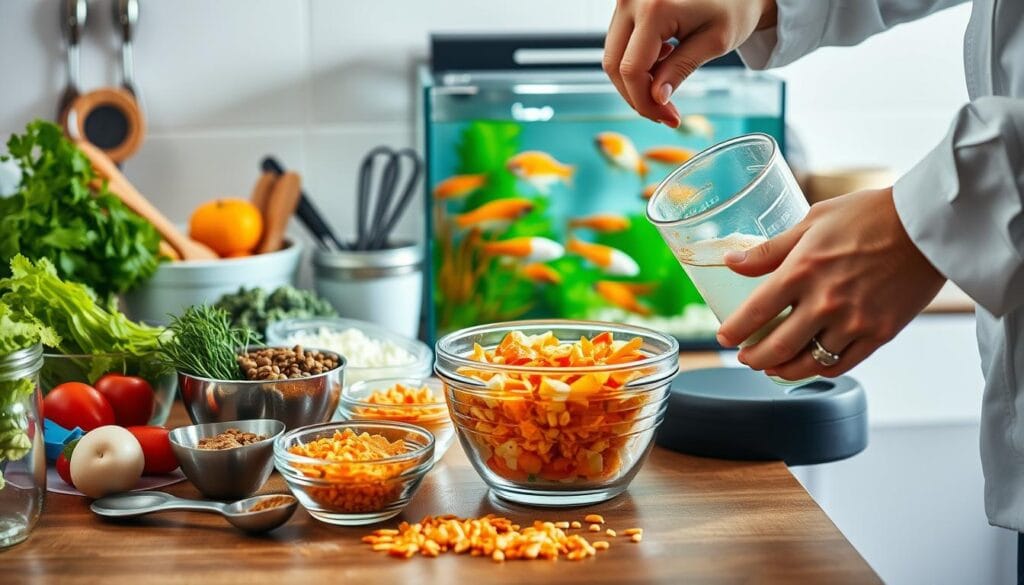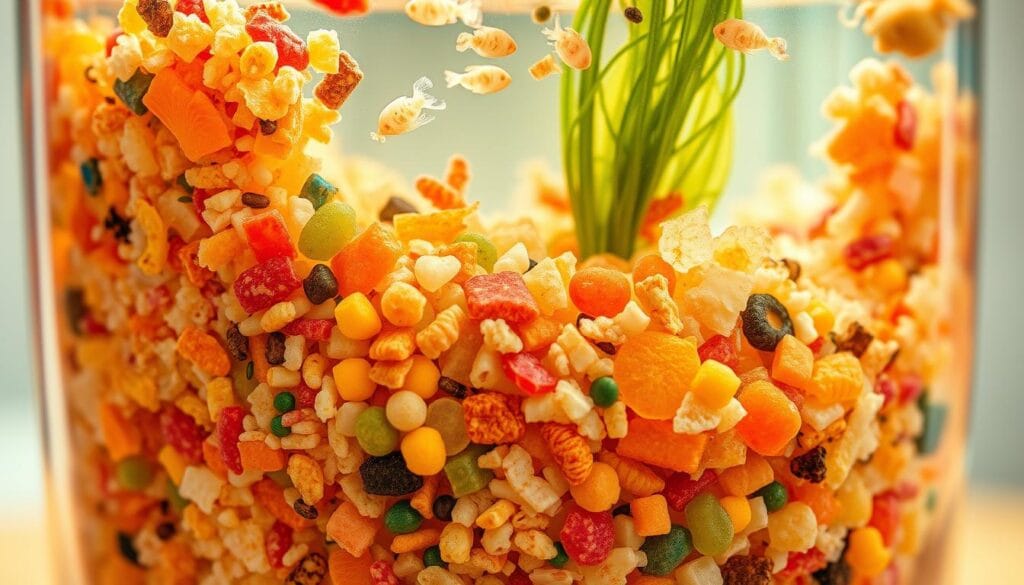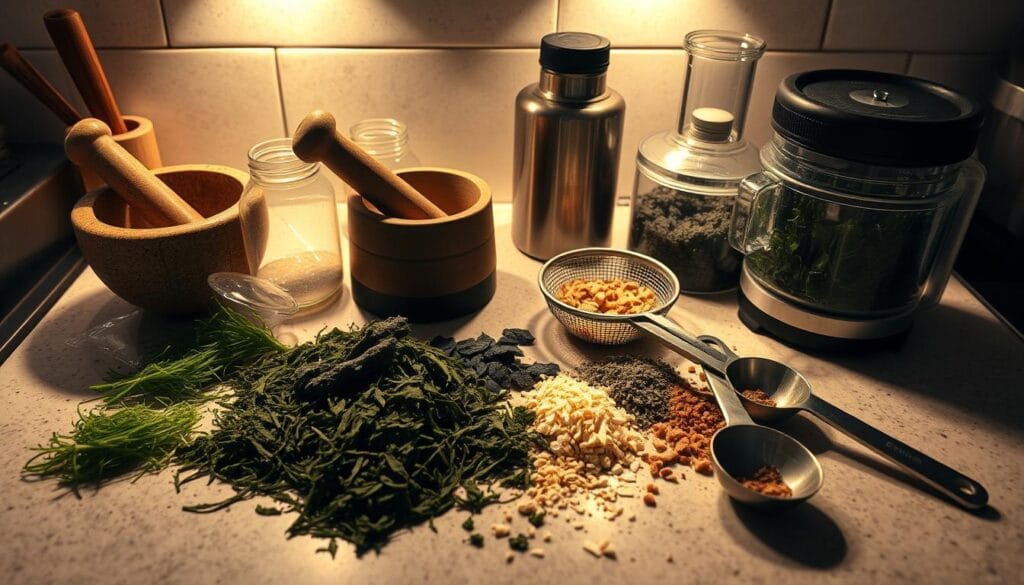Every aquarium lover knows the pain of seeing their fish suffer from bad food. I learned this the hard way when my tropical guppies lost their color and energy. This happened after years of using store-bought food.
Making your own fish food is more than a hobby. It’s a promise to your fish’s health. By making your own food, you control what they eat. This means no bad fillers or preservatives for them.
This guide will show you how to make healthy, affordable fish food at home. You’ll see how kitchen ingredients can become great food for your fish. It saves money and keeps your fish healthy.
Whether you’re new to aquariums or have been keeping fish for years, these DIY tips will change how you feed them. You’ll become your fish’s own nutrition expert!
Understanding the Importance of Homemade Fish Food
Aquarium nutrition has changed a lot in recent years. More people are making their own fish food. This isn’t just a trend. It’s a smart way to feed your fish well and protect the environment.

Homemade fish food has big advantages over store-bought. You control what goes into it, how nutritious it is, and how fresh. This is something commercial foods can’t offer.
Benefits of DIY Fish Food
- Customized nutrition for specific fish species
- Elimination of unnecessary preservatives
- Guaranteed ingredient transparency
- Reduced exposure to potential contaminants
Cost-Effectiveness and Quality Control
Making your own fish food can save you money. Commercial foods can be pricey. But, making your own lets you buy ingredients in bulk and tailor meals to your fish’s needs.
| Aspect | Commercial Food | Homemade Food |
|---|---|---|
| Cost per Serving | $0.50 – $1.50 | $0.10 – $0.75 |
| Ingredient Control | Limited | Complete |
| Nutritional Customization | Standard Formulation | Species-Specific |
Environmental Impact Considerations
Homemade fish food is good for the planet too. It cuts down on packaging waste and carbon emissions from big commercial products.
“Homemade fish food represents a small but meaningful step towards responsible aquarium management.” – Aquatic Nutrition Experts
By making your own fish food, you show you care about your fish and the planet. It shows you understand the importance of good nutrition and taking care of our environment.
Essential Nutrients Your Fish Need Daily

It’s key to know what your fish need to stay healthy. Each fish type has its own diet needs. But, there are some nutrients that all fish need every day.
Your fish need a balanced diet with important nutrients:
- Proteins: Important for growth and fixing tissues
- Carbohydrates: Their main energy source
- Fats: Helps store energy and build cell membranes
- Vitamins: Helps with metabolism
- Minerals: Keeps bones and scales strong
Protein is very important for fish. They need good protein to grow muscles and stay healthy. Most fish need 35-50% protein in their food, based on their type and age.
“Nutrition is the foundation of fish health and longevity” – Marine Biology Research Institute
Vitamins and minerals are also crucial. Vitamins like C, D, and E help with metabolism. Minerals like calcium and phosphorus are important for bones and growth.
When making your own fish food, try to match their natural diet. This ensures they get all the nutrients they need.
Basic Equipment and Ingredients for Making Fish Food
Making homemade fish feed needs the right tools and ingredients. Your kitchen can become a place to make fish food with basic tools and the right ingredients.

Before starting your fish food recipe, knowing the essential tools and ingredients is key.
Required Kitchen Tools
- Food processor or blender
- Sharp cutting board
- Measuring cups and spoons
- Mixing bowls
- Spatula or mixing spoon
- Fine mesh strainer
- Kitchen scale
Core Ingredients List
Your homemade fish feed needs a mix of proteins, veggies, and supplements. Choosing quality ingredients is important for nutritious fish food.
| Protein Sources | Vegetable Components | Supplements |
|---|---|---|
| Shrimp | Spinach | Spirulina powder |
| Fish fillets | Zucchini | Vitamin mix |
| Egg whites | Peas | Mineral supplements |
Storage Containers and Preservation Methods
Storing your homemade fish feed right is key. Choose containers that keep out moisture and air.
“Fresh ingredients and proper storage are the secrets to creating high-quality fish food at home.” – Aquarium Nutrition Expert
- Use glass or BPA-free plastic containers
- Label containers with preparation date
- Store in cool, dry place
- Refrigerate fresh batches
- Consume within 3-5 days for optimal nutrition
Investing in quality tools and learning how to store food well will help you make nutritious homemade fish feed. This supports your aquatic pets’ health.
Best Protein Sources for Homemade Fish Feed
Making homemade fish food means knowing the best proteins for fish. Each fish type needs different foods for health and growth.
Choose from animal and plant proteins for fish. Good protein helps with growth, immune health, and energy.
- Animal-based protein sources:
- Fresh fish meat
- Shrimp
- Krill
- Earthworms
- Bloodworms
- Plant-based protein sources:
- Spirulina
- Soybean meal
- Algae
- Pea protein
Different fish need different protein levels. Meat-eaters need more animal protein, while plant-eaters do better with plant proteins.
| Protein Source | Protein Percentage | Best For |
|---|---|---|
| Fish Meal | 60-72% | Carnivorous Fish |
| Spirulina | 60-70% | Herbivorous Fish |
| Shrimp Meal | 40-50% | Omnivorous Fish |
“The right protein source can transform your fish’s health and vitality.” – Aquarium Nutrition Expert
When making fish food at home, mix proteins for a balanced diet. Always research your specific fish species’ nutritional requirements to ensure optimal health.
Simple Fish Food Recipe for Beginners
Making your own fish food is fun and rewarding. Homemade pellets are a great choice over store-bought ones. You get to control what your fish eat.
To start making fish food, you need some basic knowledge and simple ingredients. The right recipe gives your fish the nutrients they need to stay healthy and grow.
Step-by-Step Preparation Guide
Here’s how to make nutritious fish pellets at home:
- Gather high-quality protein sources like shrimp, fish, or squid
- Blend proteins with vegetable ingredients
- Add essential vitamins and minerals
- Mix ingredients thoroughly
- Form into small pellets
- Dry the fish pellets completely
Storage and Preservation Techniques
Keeping your homemade fish food fresh is key. Store the pellets in an airtight container in a cool, dry place. Refrigeration can keep them fresh for up to two months.
“Fresh, homemade fish food can significantly improve your aquarium’s ecosystem.” – Marine Biology Experts
Feeding Recommendations
Start with small amounts of your homemade pellets. Watch how your fish react and adjust the amount as needed. Most fish need to eat 2-3 times a day, and they should finish their food in 2-3 minutes.
- Monitor fish behavior after introducing new food
- Adjust portion sizes based on fish species
- Remove uneaten food to maintain water quality
Making your own fish food recipe lets you give your fish the nutrition they need.
Creating Vegetable-Based Fish Food Blends
Making a vegetable mix for fish can greatly boost their health and nutrition. Fish that eat plants do well on diets rich in nutrients. These diets also help their digestive systems.
When making your fish’s vegetable mix, think about these important ingredients:
- Spinach: Rich in vitamins and minerals
- Zucchini: Easily digestible and hydrating
- Spirulina: Nutrient-dense algae supplement
- Blanched lettuce: Low-calorie green option
- Boiled peas: Protein and fiber source
“The right vegetable blend can transform your fish’s diet from basic sustenance to optimal nutrition.” – Aquarium Nutrition Expert
To prepare your mix, you need to blanch or steam the veggies. This makes them softer and easier to digest. Cut them into small pieces that fit your fish’s mouth.
Your homemade mix should be 20-30% of your fish’s diet. Change up the veggies to keep the diet balanced and interesting for your fish.
Pro tip: Freeze your mix in small portions. This makes it easy to use and keeps the nutrients in your fish food.
Live Food Culture: Growing Your Own Fish Feed
Starting with live food culture is key to sustainable fish feeding. Growing your own fish feed can change your aquarium. It makes your fish healthier and happier.
Live food cultures are great for fish health. They give fish the proteins they need. They also make feeding time more fun and natural.
Cultivating Daphnia: A Nutritious Microorganism
Daphnia are tiny crustaceans that are perfect as live food. They are full of protein and easy for fish to digest.
- Requires minimal equipment
- Reproduces quickly
- Highly nutritious for fish
Brine Shrimp: The Aquarium Superfood
Brine shrimp are also a top choice for live food. They are especially good for young fish. They have lots of nutrients that help fish grow strong.
| Organism | Protein Content | Reproduction Rate |
|---|---|---|
| Daphnia | 50-60% | High |
| Brine Shrimp | 55-65% | Very High |
Maintaining Healthy Live Food Colonies
To keep live food cultures thriving, you need to care for them. Keep the water clean, the temperature stable, and feed them regularly.
“The secret to sustainable fish feeding is creating a balanced, self-sustaining ecosystem.” – Aquarium Experts
By putting effort into live food culture, you’ll give your fish a better diet. You’ll also use less commercial feed.
Advanced Fish Food Recipe for Specific Species
Making the perfect fish food recipe means knowing what each fish needs. Aquarium nutrition varies by fish type. Each fish has its own diet needs.
“Nutrition is the foundation of fish health and vitality in your aquarium.” – Aquatic Nutrition Expert
When making advanced fish food recipes, think about your fish’s diet type:
- Carnivorous fish: Need high-protein ingredients
- Herbivorous fish: Need plant-based nutrition
- Omnivorous fish: Benefit from balanced protein and vegetable sources
Your recipe should use ingredients that match their natural diet. For carnivorous fish like bettas and cichlids, use protein-rich foods.
| Fish Type | Protein Source | Key Nutrients |
|---|---|---|
| Carnivores | Shrimp, Fish Meat | High Protein, Omega-3 |
| Herbivores | Spirulina, Vegetables | Fiber, Vitamins |
| Omnivores | Mixed Ingredients | Balanced Nutrition |
Creating a customized fish food recipe means choosing the right ingredients and mixing them right. Try different mixes to find what’s best for your fish.
Remember, aquarium nutrition is a continuous process. Watch your fish’s health, growth, and behavior to adjust your homemade fish food recipe.
Supplementing Homemade Fish Food
Making fish food at home needs careful thought about what fish need to eat. Homemade recipes are great, but adding supplements can make your fish even healthier.
Knowing what vitamins and minerals fish need can make your supplements better. Fish need a diet that’s close to what they eat in nature.
Essential Vitamins and Minerals for Optimal Fish Health
- Vitamin A: Supports vision and immune function
- Vitamin D: Critical for calcium metabolism
- Vitamin E: Protects cell membranes
- Vitamin K: Promotes blood clotting
Natural Supplement Options
Adding natural supplements to your homemade fish food can boost its nutrition. Here are some great choices:
| Supplement | Nutritional Benefits | Recommended Dosage |
|---|---|---|
| Spirulina | High protein, antioxidants | 2-5% of total diet |
| Garlic | Immune system booster | 1% of total mixture |
| Bee Pollen | Mineral-rich supplement | 1-2% of diet |
“Nutrition is the foundation of fish health. Strategic supplementation can make a significant difference in your aquarium’s ecosystem.” – Marine Biology Research Institute
Start with small amounts of supplements and watch how your fish react. Each fish type has its own food needs, so keep an eye on their health.
Pro tip: Change up your supplements to give your fish a wide range of nutrients and avoid too much of one thing.
Common Mistakes to Avoid When Making Fish Food
Making homemade fish feed needs a lot of attention. Many people make big mistakes that can hurt their fish. Knowing these mistakes helps you make safe and healthy fish food.
- Nutrient Imbalance: Not mixing proteins, carbs, and minerals right can cause malnutrition
- Improper Ingredient Selection: Not all human foods are good for fish. Stay away from processed or seasoned foods
- Contamination Risks: Dirty surfaces and tools can add bad bacteria to your fish food
When making fish food, being precise is key. Experts say to measure ingredients well and know what your fish need.
“The key to successful homemade fish food is research and careful preparation.” – Marine Biology Research Institute
Storing fish food right is also important. Bad storage can make nutrients go bad fast. Always use tight containers and keep them cold.
- Choose fresh, good-quality ingredients
- Freeze parts right after making them
- Mark containers with when you made them
- Use homemade fish food within the right time
Feeding too much is a big mistake. Even with great homemade food, don’t overdo it. Make a regular feeding plan for your fish.
Seasonal Variations in Fish Food Recipes
Making the perfect fish food recipe means knowing how seasons change what your fish need. It’s not just about feeding them once and for all. You need to adjust their food all year to keep them healthy and happy.
Fish need different things as the weather changes. Your homemade fish food recipe must change with the seasons. This way, your fish stay full of energy and health.
Summer Blend Recommendations
In summer, fish are more active and burn more energy. Your fish food recipe should be more energetic too:
- Increase protein content by 10-15%
- Use lighter, more digestible ingredients
- Add extra omega-3 fatty acids
- Incorporate more fresh vegetable matter
Winter Feeding Adjustments
In winter, fish move slower and eat less. Your feeding plan should slow down too:
- Reduce overall food quantity
- Focus on nutrient-dense, high-energy ingredients
- Use more complex carbohydrates
- Minimize protein to prevent waste buildup
“Seasonal adaptation is key to maintaining healthy, vibrant fish throughout the year.” – Aquarium Nutrition Experts
By changing your fish food recipe with the seasons, you help your fish stay healthy. And you’re also being kind to the planet by feeding them sustainably.
Conclusion
Creating your own fish food is more than a hobby. It’s a big step for your aquarium’s health. By making homemade fish feed, you give your fish the best nutrition. You also save money and learn a lot about their needs.
Exploring DIY fish food opens up new nutritional options. You can make meals rich in protein or vegetables. This knowledge helps you meet your fish’s dietary needs better.
Creating homemade fish food is a journey. Start with simple recipes and watch how your fish react. Then, you can make changes to improve their health.
Be proud of making fish food at home. Your effort will show in your fish’s health and happiness. Keep trying new things and enjoy the journey of becoming an expert in aquarium nutrition.

